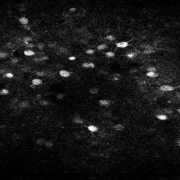Feedforward circuits have been shown to be very powerful as models of vision. However, these architectures are apparently incapable of dealing with many visual tasks that the human visual system finds simple, such as identifying occluded figures. Data from the Allen Institute for Brain Science Cortical Activity Map (CAM) project may give us the opportunity to explore this question. What is the functional connectivity of cells in mouse V1 during awake passive viewing of various stimuli (gratings, noise, natural scenes)? How is this connectivity involved in the computations of the visual cortex? In what ways does it underlie or mediate information processing? Can we find evidence that such connectivity is important for visual tasks such as identifying occluded figures? Can we build recurrent computational architectures guided by these models that will overcome the limitations of known feedforward architectures? We will address these questions by fitting statistical models to the CAM data sets from which we will derive functional connectivity. These models will inform the development and training of new computational architectures for object recognition.
Neural Circuits for Intelligence
 Abstract thinking and complex problem solving constitute paradigmatic examples of computation emerging from interconnected neuronal circuits. The biological hardware represents the output of millions of years of evolution leading to neuronal circuits that provide fast, efficient, and fault-tolerant solutions to complex problems. Progress toward a quantitative understanding of emergent intelligent computations in cortical circuits faces several empirical challenges (e.g., simultaneous recording and analysis of large ensembles of neurons and their interactions), and theoretical challenges (e.g., mathematical synthesis and modeling of the neuronal ensemble activity). Our team of theoreticians and neurophysiologists is focused on systematic, novel, and integrative approaches to deciphering the neuronal circuits underlying intelligence. Understanding neuronal circuits that implement solutions to complex challenges is an essential part of scientific reductionism, leading to insights useful for developing intelligent machines.
Abstract thinking and complex problem solving constitute paradigmatic examples of computation emerging from interconnected neuronal circuits. The biological hardware represents the output of millions of years of evolution leading to neuronal circuits that provide fast, efficient, and fault-tolerant solutions to complex problems. Progress toward a quantitative understanding of emergent intelligent computations in cortical circuits faces several empirical challenges (e.g., simultaneous recording and analysis of large ensembles of neurons and their interactions), and theoretical challenges (e.g., mathematical synthesis and modeling of the neuronal ensemble activity). Our team of theoreticians and neurophysiologists is focused on systematic, novel, and integrative approaches to deciphering the neuronal circuits underlying intelligence. Understanding neuronal circuits that implement solutions to complex challenges is an essential part of scientific reductionism, leading to insights useful for developing intelligent machines.

